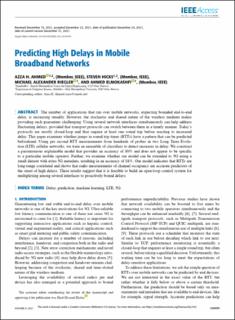| dc.contributor.author | Mohamed Ahmed, Azza Hassan | |
| dc.contributor.author | Hicks, Steven | |
| dc.contributor.author | Riegler, Michael | |
| dc.contributor.author | Elmokashfi, Ahmed Mustafa Abdalla | |
| dc.date.accessioned | 2022-12-06T12:38:04Z | |
| dc.date.available | 2022-12-06T12:38:04Z | |
| dc.date.created | 2022-01-28T21:09:53Z | |
| dc.date.issued | 2021-12-24 | |
| dc.identifier.citation | IEEE Access. 2021, 9 168999-169013. | en_US |
| dc.identifier.issn | 2169-3536 | |
| dc.identifier.uri | https://hdl.handle.net/11250/3036132 | |
| dc.description.abstract | The number of applications that run over mobile networks, expecting bounded end-to-end delay, is increasing steadily. However, the stochastic and shared nature of the wireless medium makes providing such guarantees challenging. Using several network interfaces simultaneously can help address fluctuating delays, provided that transport protocols can switch between them in a timely manner. Today’s protocols are mostly closed-loop and thus require at least one round trip before reacting to increased delay. This paper examines whether jumps in round trip times (RTTs) have a pattern that can be predicted beforehand. Using per second RTT measurements from hundreds of probes in two Long Term Evolution (LTE) cellular networks, we train an ensemble of classifiers to detect increases in delay. We construct a parsimonious explainable model that provides an accuracy of 80% and does not appear to be specific to a particular mobile operator. Further, we examine whether our model can be extended to 5G using a small dataset with extra 5G metadata, resulting in an accuracy of 88%. Our model indicates that RTTs are long-range correlated and shows that radio measurements of channel occupancy are accurate predictors of the onset of high delays. These results suggest that it is feasible to build an open-loop control system for multiplexing among several interfaces to proactively bound delays. | en_US |
| dc.language.iso | eng | en_US |
| dc.publisher | Institute of Electrical and Electronics Engineers | en_US |
| dc.relation.ispartofseries | IEEE Access;Volume 9: 2021 | |
| dc.rights | Navngivelse 4.0 Internasjonal | * |
| dc.rights.uri | http://creativecommons.org/licenses/by/4.0/deed.no | * |
| dc.subject | Delays | en_US |
| dc.subject | Predictions | en_US |
| dc.subject | Machine learning | en_US |
| dc.subject | Long term evolution | en_US |
| dc.subject | LTE | en_US |
| dc.subject | 5G | en_US |
| dc.title | Predicting High Delays in Mobile Broadband Networks | en_US |
| dc.type | Peer reviewed | en_US |
| dc.type | Journal article | en_US |
| dc.description.version | publishedVersion | en_US |
| cristin.ispublished | true | |
| cristin.fulltext | original | |
| cristin.qualitycode | 1 | |
| dc.identifier.doi | https://doi.org/10.1109/ACCESS.2021.3138695 | |
| dc.identifier.cristin | 1992955 | |
| dc.source.journal | IEEE Access | en_US |
| dc.source.volume | 9 | en_US |
| dc.source.issue | 9 | en_US |
| dc.source.pagenumber | 168999-169013 | en_US |

